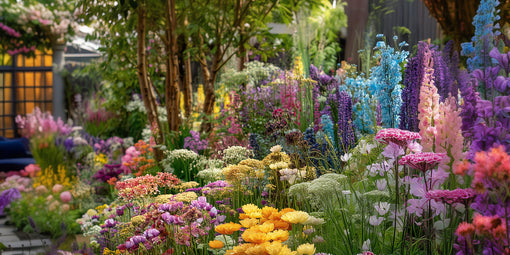
- Article published at:
Drawer menu

Everyone here at LÖV Flowers absolutely loves spending time in nature, and we can't help but be drawn to the delicate and charming beauty of the sweet pea flower. Sweet peas have been admired for centuries, and in this post, we will explore their appearance, symbolism, uses, and fascinating trivia..
But why are sweet pea flowers so special? Well, for starters, they come in a wide variety of colours and have a unique and delightful fragrance. And as we'll soon discover, they have significant cultural and historical significance, medicinal properties, and culinary uses. Sweet peas are not only a lovely treat for the senses but also have a rich and fascinating backstory!
Let's dive in and discover the wonderful world of the sweet pea flower together.
Sweet pea flowers are absolutely stunning to behold! They have a delicate and airy appearance with ruffled petals that resemble tiny butterflies. They come in a variety of colours including pink, purple, white, and even bi-colours like blue and white or pink and red.

And let's not forget their heavenly fragrance! The scent of sweet pea flowers is sweet and refreshing, like a mix of honey and freshly cut grass.
Fun fact: did you know that some sweet pea varieties can grow up to 6 feet tall? But don't let their delicate appearance fool you - sweet peas are hardy plants that can tolerate cooler temperatures and even light frosts. Overall, sweet pea flowers are a delight for the eyes, nose, and soul!
Sweet pea flowers are more than just a pretty face - they also carry significant symbolism and meaning. In literature and art, sweet peas are often associated with sentiments of appreciation, gratitude, and blissful pleasure.
And in different cultures, they have different meanings - in Victorian England, for example, sweet peas were often given as a sign of departure or goodbye. But our favourite symbolism of sweet pea flowers is their association with friendship.


In fact, in the language of flowers, sweet peas represent lasting friendship and are a perfect gift to give to your bestie or someone you cherish. So the next time you want to show someone how much you appreciate them, consider gifting them a bouquet of sweet peas.
Sweet pea flowers have many practical uses beyond just being a feast for the eyes and nose. In the garden, sweet peas make for a beautiful ornamental plant that can add a pop of colour and texture to any landscape.
But did you know that sweet peas also have medicinal properties? Sweet pea extract is believed to have anti-inflammatory and antioxidant benefits and has been used for centuries in traditional medicine.


And for all you foodies out there, sweet peas are edible too! You can add the flowers or the young shoots to salads, use the dried flowers to flavour teas or desserts, or even try making sweet pea flower syrup for a unique and refreshing addition to cocktails.
Lathyrus odoratus (Sweet Pea) - Edible Flowers (in moderation):
The most common sweet pea species, Lathyrus odoratus, is generally grown for its beautiful flowers and fragrance. The flowers themselves can be edible but only in moderation. They can be used as a garnish, in salads, or for decoration in cakes or drinks.
Important note: The seeds of Lathyrus odoratus are toxic and should never be consumed, even in small quantities. Eating the seeds can cause nausea, vomiting, and potentially more severe symptoms.
And that's a wrap on our exploration of sweet pea flowers! We hope you enjoyed learning about these delightful blooms. Sweet peas truly are a versatile and fascinating flower that have captured the hearts of people around the world for centuries.
Whether you grow them in your garden, use them for medicinal purposes, or simply admire their beauty and fragrance, there's no denying that sweet pea flowers are a treat for the senses.
So the next time you come across a sweet pea flower, take a moment to appreciate its delicate petals, sweet aroma, and rich history. And who knows - maybe you'll be inspired to plant some sweet pea seeds of your own and add a touch of charm to your own corner of the world.
What's your favourite thing about sweet peas? Pop a comment in the field below and let us know!